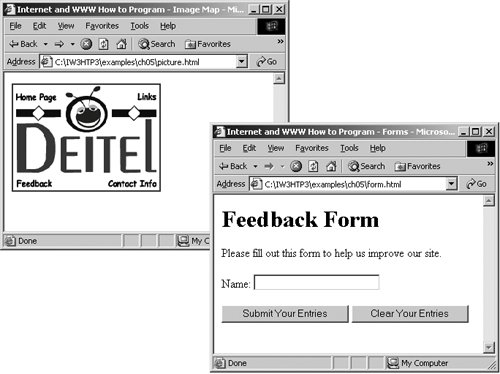Section G.7. Creating and Using Image Maps
G.7. Creating and Using Image MapsIn Appendix F, we demonstrated how images can be used as hyperlinks to link to other resources on the Internet. In this section, we introduce another technique for image linking called image maps, which designates certain areas of an image (called hotspots) as links.[1] Figure G.7 introduces image maps and hotspots.
Figure G.7. Image with links anchored to an image map.
Lines 2048 define an image map by using a map element. Attribute id (line 20) identifies the image map. If id is omitted, the map cannot be referenced by an image (which we will see momentarily). Hotspots are defined with area elements (as shown in lines 2527). Attribute href (line 25) specifies the link's target (i.e., the resource to which to link). Attributes shape (line 25) and coords (line 26) specify the hotspot's shape and coordinates, respectively. Attribute alt (line 27) provides alternative text for the link. Common Programming Error G.4
The markup in lines 2527 creates a rectangular hotspot (shape = "rect") for the coordinates specified in the coords attribute. A coordinate pair consists of two numbers representing the locations of a point on the x-axis and the y-axis, respectively. The x-axis extends horizontally and the y-axis extends vertically from the upper-left corner of the image. Every point on an image has a unique x-y-coordinate. For rectangular hotspots, the required coordinates are those of the upper-left and lower-right corners of the rectangle. In this case, the upper-left corner of the rectangle is located at 2 on the x-axis and 123 on the y-axis, annotated as (2, 123). The lower-right corner of the rectangle is at (54, 143). Coordinates are measured in pixels. Common Programming Error G.5
The map area at lines 3941 assigns the shape attribute "poly" to create a hotspot in the shape of a polygon using the coordinates in attribute coords. These coordinates represent each vertex, or corner, of the polygon. The browser connects these points with lines to form the hotspot's area. The map area at lines 4547 assigns the shape attribute "circle" to create a circular hotspot. In this case, the coords attribute specifies the circle's center coordinates and the circle's radius, in pixels. To use an image map with an img element, you must assign the img element's usemap attribute to the id of a map. Lines 5253 reference the image map "#picture". The image map is located within the same document, so internal linking is used. |
EAN: 2147483647
Pages: 435
